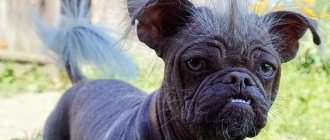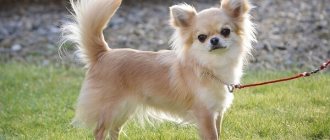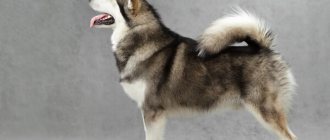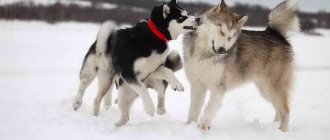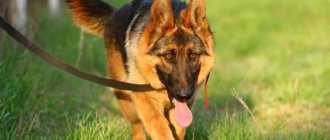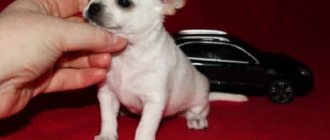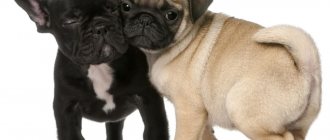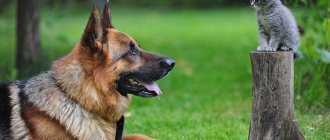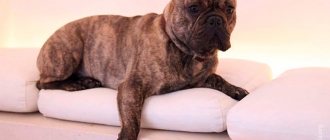The Pug and the French Bulldog are two popular compact-sized breeds of indoor dogs. Future dog owners often choose one of them, each of which has an interesting and unusual exterior. These two breeds are the ideal solution for those who need a companion and a loyal friend. Dogs are similar in many ways, but each has its own distinctive features.
What is the difference between a pug and a French bulldog? What do these two breeds have in common? Which dog is easier to care for? Which is better to choose: a pug or a French bulldog? Which breed tolerates loneliness easier? Look for answers to all these questions in our article.
Stories of both breeds
How did miniature French bulldogs come about?
The ancestors of the Frenchies are English bulldogs. Bulldogs were bred as fighting dogs that took part in fighting bulls. French bulldogs (which were actually bred in England, not France) were also initially used for these purposes, but after the ban on dog fighting, these four-legged dogs began to be perceived by people as ordinary pets.
When the breed came to France with immigrants, it came under the attention of the French elite. The price for the dog was very high, so such a pet was considered a companion of the rich. The French elite gave the familiar name to this bulldog.
The French came to Russia in the first half of the nineteenth century. They were brought to an exhibition in St. Petersburg, thanks to which this dog became in demand. Famous people turned her on: writers, singers, actors.
How did pugs appear?
According to the generally accepted version, pugs came to us from ancient China seven to eight centuries ago. During this period, the Chinese nobility kept pugs with long and short hair. Short-haired representatives were especially valued because the folds on their forehead formed a pattern that reminded the Chinese of imperial hieroglyphs.
Pugs were brought to Europe only in the mid-sixteenth century. First, pugs were brought to France, and then they spread to other countries - England, the Netherlands, etc. And later the breed came to Russia. The familiar pugs we see today took 20 years to develop.
Who is better?
Having studied all the details and features of each breed, we can come to the following conclusion.
If you are a person leading an active lifestyle, with ever-inextinguishable energy and looking for a companion in all your activities, if you have the time and desire to constantly play and train your pet, the best option for you will, of course, be a pug.
This baby is very sociable, playful, and he will not mind going on a trip with you - he will not cause any trouble along the way.
On the contrary, if you are not a supporter of an active lifestyle and are not ready to constantly spend time playing, walking and training your puppy, the French Bulldog is an excellent alternative. His funny appearance and cheerful but balanced disposition will charm you completely.
French bulldog and pug: comparison
Next, there will be a comparison of the French Bulldog or Pug breed and an analysis of what features are inherent in both dogs.
Differences
If you take a closer look at the appearance of both dogs, it becomes obvious that they look completely different. So, the differences between the exteriors of a pug and a bulldog are as follows:
- Sight. Pugs are characterized by being thoughtful and sad, while Frenchies are characterized by being lively and loving.
- The French Bulldog has larger and more powerful jaws.
- Another noticeable difference is the ears. In pugs they are raised and small. In bulldogs, on the contrary, they are erect and large, slightly pointed towards the tip.
- Pugs have a curled tail, while Frenchies have a short tail and can be straight or with a slight bend.
- Coat color. It is the common peach coloring and darker face of the pug and bulldog that confuses people into confusion. Although both dogs have completely different coat colors. For example, pugs have black, which is completely uncharacteristic for a bulldog. And Frenchies, in turn, are both brindle and spotted.
You can distinguish the pug breed from the French bulldog by their character and behavior.
Pugs are sociable dogs. They are not aggressive and get along well with children, other animals and strangers. But a pug and a pug don’t get along well under the same roof. This is almost always accompanied by fights, even if the kids grow up side by side from a young age.
In addition, pugs are gluttonous and literally omnivorous. Even a poorly placed piece of soap will end up in their mouths. This is mainly due to the dog’s lack of training, so the problem can be corrected. At a young age, these dogs are often stubborn and do not obey their owner.
Pugs are easy to train because they have excellent memory and ingenuity. Even a beginner who has never done this before can train a pet. Education should be done during the same period when the puppy gets to its new home. We need to show the little pug that man is the boss in the house. But overly intense training is contraindicated for pugs, because due to the structure of their faces, they often have difficulty breathing.
The French bulldog is no less sociable dog if you compare it with a pug. It is not advisable to leave your Frenchie alone with a tiny child. But dogs get along and are friends with older children. Francises are jealous because they love their person incredibly. Therefore, any animal or stranger who lingers near the owner for a long time will become a real competitor and even an enemy in the eyes of the pet. Again, a pet’s behavior largely depends on its upbringing.
But training a Frenchie is not an easy task. After all, their ancestors were fighting dogs, which affected the character of the modern bulldog. At times he is capable of showing disobedience and obstinacy.
Therefore, the first thing education begins with is explaining to the puppy who is really the boss in the house. The Bulldog will take advantage of any relaxation on the part of the owner, so it is necessary to constantly maintain equanimity and severity. The opposite will lead to the fact that the pet will stop responding to commands, thereby putting itself in danger. For example, it will chase another animal and get run over, or it will completely run away from its owner in an unknown direction and not return. Therefore, you cannot trust a small child or an elderly person to walk with a pet. Franz can easily pull the leash away from them.
Similarities
If we consider external similarities, then they certainly exist. Both the pug and the bulldog are medium-sized animals with pronounced muscularity and stockiness. Another striking similarity is the short muzzle (brachycephaly), slightly upturned.
As for character, both breeds are devoted to their family and are ready to love it until the very end. If you raise and train dogs in time, they will grow up to be docile. Life expectancy and health also depend on the owner. If you feed and care for your pet properly, it will live much longer.
Character
The character of both pets is dominated by playfulness and friendliness, so together these animals make an excellent team. Pugs are more flexible, so they blindly trust strangers. Bulldogs are independent, with protective qualities. They can fight back against an offender without any problems, unlike pugs.
Note! Despite the fighting disposition, the French breed cannot be called aggressive.
However, if we compare negative habits, then here too the pug and the bulldog have many similarities. Both pets have a proud and stubborn disposition. Sometimes it is difficult to make them obey, especially during walks or water procedures.
Advantages and disadvantages
Let's highlight the pros and cons of French Bulldog vs Pug to compare the four-legged dogs. Each breed has advantages and disadvantages, which are best known in advance.
French bulldogs
The advantages of the breed are:
- “compactness”, ease of keeping in an apartment. There are no difficulties with transporting your pet, you can take it on trips;
- savvy dogs capable of learning many different commands;
- do not bark without a reason, they do this rarely;
- not aggressive towards children and other animals. However, it is not advisable to leave a Frenchman with a very small child.
If we consider the shortcomings of the French, we can find the following:
- The dog is quite stubborn. She won't do anything she doesn't like. To prevent such behavior, the owner is required to be persistent and strict;
- the pet snores quite loudly;
- tendency to obesity due to love of food;
- In most cases, the female cannot give birth naturally, so childbirth is carried out by caesarean section.
Pug cubs
The advantages of pugs are as follows:
- “compactness”, ease of maintenance in an ordinary apartment. There are no difficulties with transporting the dog, you can take it on trips;
- a loyal and deeply attached pet to people;
- easy to train if you start training in a timely manner;
- safe for small children, able to easily get along with them and play.
The disadvantages of pugs are:
- trust in strangers;
- they know how to manipulate people when they want to achieve something. For example, a pug may pretend to be sick in order to lure a treat from its owner or to avoid training lessons;
- periodically become stubborn and self-willed. If you do not train your puppy from early childhood, he will grow up to be aggressive and obstinate;
- gluttony. Moreover, the pet will not figure out whether the object in front of it is edible. He'll just eat it;
- tendency to obesity as a consequence of gluttony.
Pet selection criteria
In what cases should you give preference to pugs:
- if there are many people living in the apartment and there are children;
- if it is not possible to walk the dog often;
- when the living space is small.
Disadvantages of such pets:
- not suitable for allergy sufferers;
- bark loudly;
- may damage some interior items.
Pugs are suitable for large families with children
Who is best suited for French Bulldogs:
- people who have other pets in the apartment;
- for those who don't like barking.
Disadvantages of such pets:
- snore in their sleep;
- prone to dermatitis;
- can't stand the cold.
French Bulldogs do not tolerate cold well
Comparing these two breeds, we can say that the differences are insignificant in terms of maintenance and care. However, if a person is not ready for daily walks and active games, then pugs should be preferred.
I love both of these breeds very much. Of course, both will have to be looked after, since dogs have their own characteristics and weaknesses. The advantage of such breeds, it seems to me, is that these pets can be fed not only with specialized food, but also with natural food. In addition, small dogs will not eat much, which is very economical. In terms of appearance, I prefer French bulldogs, but otherwise I would prefer pugs.
Proneness to diseases in breeds
Both Pugs and Frenchies are prone to a number of diseases that can greatly shorten a pet's life. Most diseases in dogs occur due to improper care and supervision. Therefore, full responsibility for the health of the pet always lies with the owner. One of the most important factors is feeding. Given the gluttony of both breeds and the high risk of developing obesity, it is necessary to carefully plan the animal’s diet.
Diseases characteristic of pugs:
- Diseases associated with the respiratory system. This is caused by the specific structure of the dog's head. In addition, pugs are prone to colds and their complications - rhinitis, bronchitis, etc.
- Allergic reactions. They arise not only from food, but also from pollen.
- Dental problems: inflammation, periodontitis, caries, problems with the eruption of molars in puppies.
- Eye diseases: conjunctivitis, impaired lacrimation. More dangerous diseases such as cataracts or glaucoma often occur.
- Skin diseases such as dermatitis. Most often it is localized on the forehead, where the pug has dense folds.
- If your dog is obese, the risk of heart and vascular diseases increases.
- Convulsive seizures. This is not exactly epilepsy, but the symptoms are similar. Typically, a dog's tendency to have seizures is inherited.
Diseases common to French bulldogs:
- Spinal diseases.
- Eye diseases, such as conjunctivitis. Another common problem is entropion of the eyelids.
- Narrowing (stenosis) of the nasal passages, making it difficult for the dog to breathe.
- Skin diseases, including dermatitis.
- Allergic reactions. Like the Pug, the Frenchie is prone to food and pollen allergies.
- Difficult birth. As noted above, it is difficult for a female French Bulldog to give birth naturally because newborn puppies have large heads.
- Obesity and subsequent cardiovascular diseases.
Host reviews
Igor
“The French bulldog is a sociable dog; our Bonya cannot live without human company. This leads to several main disadvantages: the dog snores loudly and interferes with sleep. There is no way to kick him out to another room, because there is no way to sleep without the owner. The smell from it is also not the most pleasant at times (to put it mildly), if you know what I mean. There may be problems with nutrition; bulldogs are sensitive to food allergies. We changed the food 10 times until we found the right one.”
Lena “The decision to get a pug was not made spontaneously. I am very pleased with Mara, despite a number of difficulties that we encountered. Firstly, pugs are prone to overeating and I noticed this very quickly. Mara even steals from the table. This leads to problems with excess weight and illnesses, but if you watch your diet, everything will be fine. Pugs also need a lot of time outdoors. And Mara constantly hides my shoes. I think this is due to the fact that she doesn't want me to leave. Despite everything, I love this naughty girl.”
Specifics of caring for a pug and French bulldog
The requirements for caring for a pug and a Frenchie are almost the same. Competent care includes compliance with the following rules:
- Balanced diet. It is allowed to feed either dry food (only premium and higher classes) or natural products.
- When walking in cold weather, your pets should wear warm clothes.
- You don’t need to wash your dogs often; it’s enough to periodically bathe and comb their fur.
- Maintaining an activity regime.
- Overheating must not be allowed. This is deadly for such dogs.
Summarizing
When choosing between a pug and a French bulldog, a person should remember their differences and similarities. The difference between the breeds lies in size (Frenchies are larger than pugs), the level of activity of the dogs (pugs are calmer and more balanced), as well as nuances of appearance (which dog is cuter is a matter of taste).
In addition, the French are more temperamental and love to show willfulness, while pugs are kind-hearted, extremely fond of affection and are ready to be friends with every person who pays attention to them. At the same time, both breeds value and love their owner and family members, with proper upbringing they grow up obedient, and with proper care they live a long time and practically do not get sick.
Pug and Frenchie puppies
To purchase purebred puppies, you must contact professional nurseries or trusted breeders. Don’t forget to ask the seller for all the documents for the baby (passport, pedigree) and be sure to sign an agreement when purchasing. You have to be careful, because the puppies of these purebred dogs are practically indistinguishable in appearance.
As for the price, it is almost the same - from 10 to 40 thousand, depending on the class and pedigree of the baby.
Basic commands
- Aport. One of the most difficult teams. Many people perceive it as very easy and simple, but with many dogs you will have to work hard. This skill is used for other exercises: searching, searching, selecting an item and many others. Usually they are all used in service. When working out a command, “Aport” and “Give” are used, and a gesture is also used.
- Give. On the command “Give” the dog must give up the object.
- Lie. A connecting command that needs to be learned for other commands. In addition, it will not interfere at home or on the street.
- To me. You will need to use this command quite often. So start with it immediately after your French Bulldog puppy has learned his name. Never call the dog to punish, and do not scold if it comes on its own, even after mischievousness before it. This behavior on your part may alienate the animal.
- Place. A puppy or an adult dog must clearly know where his place is located. He can sleep anywhere, if you allow it, of course, but he must know this command. You can use it outside the home, marking the place with a leash or your favorite toy.
- Near. It is possible to teach your pet the “Near” command at any age, be it an adult dog or a small puppy. When you move to a new home, you should immediately think about training your puppy.
- Sit. One of the very first commands that a French bulldog puppy should learn.
- Stand. The command is useful in everyday life, for example, for combing a dog.
- Ugh. The prohibiting command is one of the most mandatory and taming it begins from the first day the puppy appears in the house. Requiring the command “Fu!”, “No!”, “No!” – immediately stop the unwanted action.
Differences in appearance
Since the Pug and the French Bulldog are similar in appearance, many people cannot decide which breed to buy. Despite the fact that at first glance an inexperienced person may confuse the two dogs, there are a large number of differences between them.
Head
Pugs have large, square heads. The head of females is smaller than that of males. The top of the skull (when viewed from above) should be flat between the ears. From the side view the forehead is flat. If the dog has rounded outlines, this is a reason for disqualification. There should be noticeable folds on the forehead with sufficient depth. The lower jaw is of sufficient width with a prominent chin.
The jaw is powerful and heavy. It is flattened in front, making the dog seem stern. There are also folds on the jaw and the most distinct one serves as a division of the brow ridge. This fold should not extend onto the forehead. The muzzle is short, its length is half the width of the forehead. There are folds throughout the muzzle. A narrow or weak jaw is considered a defect.
Frenchies have symmetry in the folds on their muzzle. The muzzle should be upturned, wide and short. The muzzle of a real French Bulldog is 1/6 the length of its head.
Eyes
The pug's eyes are dark in color and round, large in size. Looking at them, you might think that the animal is sad. They have a bright shine. Dull eyes symbolize the presence of some kind of disease. Protruding eyes are a serious defect, as is slanting with the appearance of whites.
Bulldogs also have round, large eyes and a dark brown color. The eye set is low and wide. The look is always endowed with liveliness and good nature. Dark eyelids are a must.
Ears
Pugs have two types of ears: rosettes and buttons. In the first case, the hall is located in the middle, the ears themselves are laid back. In the second case, the auricle is completely hidden. In two versions, the ears are small in size; they should fit tightly to the head. The French Bulldog's ears are medium in size and always point forward. A high, well-spaced seating position is a must. The shape is triangular with a wide base, the tip is rounded.
Neck
The pug has a strong, long neck with a scruff behind the back of the skull. Bulldogs, on the contrary, have a short neck with pronounced muscles. The dog should not have ligaments under its throat.
Torso
The pug is characterized by a powerful and dense body. The upper part is flat, the back should be flat, the chest should be wide. The bulldog has a strong backbone, the body itself looks compact and neat. The back also has muscles and sufficient width. The top of the body is curved and smoothly rises to the lower back, after which it sharply declines towards the tail. The abdomen and groin area are taut, the sides are rounded.
Limbs
The pug's limbs are not quite short, straight, muscular and parallel. The paws have soft and thick pads with separated toes. The limbs of Frenchies are short and strong. The toes should be closed with small paws that are slightly turned outward. The hind limbs are longer. The thighs are strong and endowed with muscles.
Tail
The pug's tail is located in a tight curl. Two turns are a valuable sign that indicates that the dog is purebred. The seat should be high and lie on one side, pressing against the thigh. The bulldog has a short tail, which is wide at the base and begins to taper towards the end, with a low set. From birth it may be knotty or broken, which indicates that the dog is purebred. The tail of some individuals is wrapped in a ring, but this is not a mandatory feature.
Wool
The pug is characterized by short fur that fits tightly to the body. It is soft to the touch and shiny in appearance. The Bulldog, on the contrary, has a short and thick coat that does not have a pronounced undercoat. Unlike a pug, a Frenchie does not shed as much and does not smell like a dog.
Color
The pug is available in several colors: silver, fawn and black. French Bulldogs come in white, white with spots, white and brindle, white and fawn, and brindle and fawn are also allowed. With any color, the presence of black eyelids is a prerequisite.
Dimensions and weight
A female pug reaches 8 kilograms with a height of 25–30 cm. A male can grow up to 30–35 cm with a weight category of 6–10 kg. French bulldog females weigh 9–12 kilograms with a height of 28–35 cm. For a male, a height of 30–38 cm with a weight category of 10–15 kg is acceptable.
What to do if your ears don't stand up
Dogs of the French Bulldog breed have open, vertical ears. When you look at them, you can see the resemblance to the ears of a bat. Due to the small size of the animal's head, its ears appear quite large. They have a wide base and an oval line at the end.
But, unfortunately, not all French bulldogs have ideal “flying” ears of the correct set. Basically, they get up when they are supposed to due to their genetic predisposition. That is why when choosing a puppy of this breed, experts advise first examining its parents.
It is worth noting that until the dog’s ears stand up, you cannot stroke its head. Otherwise, the ears may either not stand up at all, or stand up not vertically, but in different directions.
You shouldn’t wait six months if your French bulldog’s ears still haven’t grown at four or five months. The owner will have to make some efforts to help the pet's ears develop. First of all, you need to make changes to the dog's menu. To do this, you need to add calcium, cottage cheese, kefir and gelatin to your food.
The dosage of mineral supplements should be discussed with your local veterinarian, otherwise your pet may experience an overdose of medications. This will be bad for your French Bulldog's health.
If changes in the dog's diet do not help the process of ear formation, the owner will have to glue them back. To do this you need to prepare the following items:
- wide patch;
- medical cotton wool;
- bandage.
First of all, you need to roll two rolls of cotton wool five centimeters wide. The length of the roller should be two centimeters longer than the length of the French bulldog's ears. To strengthen the structure, each roller must be wrapped with a bandage.
Then you need to insert a roller vertically into each dog’s ear. Each ear must be carefully pulled out and the roller closed with its edges. Now you need to secure the resulting structure with a wide plaster, making sure that there are no folds on the skin.
Since the French Bulldog's ears must stand not only vertically, but also symmetrically, you will have to do something else. Two identical strips are cut from the patch, the length of which is equal to the sum of the distance between the ears and the length of the base of the two ears. One strip is glued horizontally in front of the ears, the other - behind.
The dog must carry the resulting structure for ten days. After this, the animal’s ears must be given a rest by removing the patch with vegetable oil and removing the rollers. If one time is not enough and the dog’s ears still do not stand up, the procedure must be repeated.
Photo gallery
No matter which breed you choose, they are both very sweet and good. With proper care of the animal, it will delight you with its grunting for many years. Let's look at the photos of these beauties.

